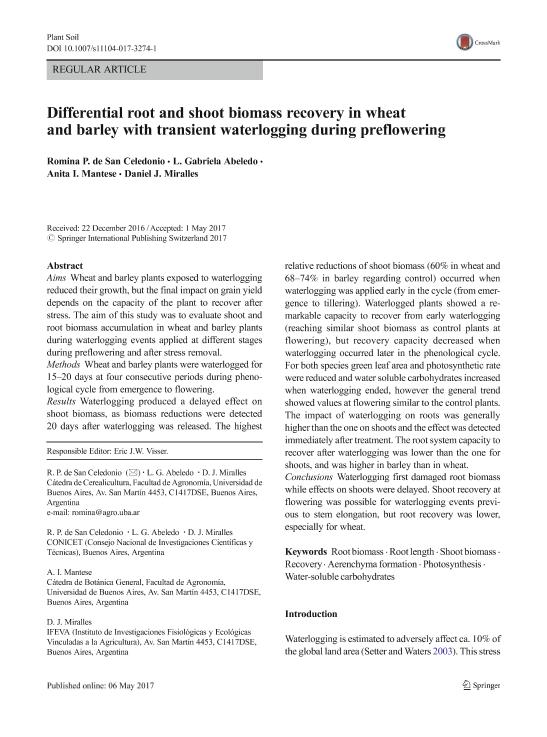Mostrar el registro sencillo del ítem
dc.contributor.author
de San Celedonio, Romina Paola

dc.contributor.author
Abeledo, Leonor Gabriela

dc.contributor.author
Mantese, Anita Ida

dc.contributor.author
Miralles, Daniel Julio

dc.date.available
2018-07-04T18:53:58Z
dc.date.issued
2017-08
dc.identifier.citation
de San Celedonio, Romina Paola; Abeledo, Leonor Gabriela; Mantese, Anita Ida; Miralles, Daniel Julio; Differential root and shoot biomass recovery in wheat and barley with transient waterlogging during preflowering; Springer; Plant and Soil; 417; 1-2; 8-2017; 481-498
dc.identifier.issn
0032-079X
dc.identifier.uri
http://hdl.handle.net/11336/51234
dc.description.abstract
Aims: Wheat and barley plants exposed to waterlogging reduced their growth, but the final impact on grain yield depends on the capacity of the plant to recover after stress. The aim of this study was to evaluate shoot and root biomass accumulation in wheat and barley plants during waterlogging events applied at different stages during preflowering and after stress removal. Methods: Wheat and barley plants were waterlogged for 15–20 days at four consecutive periods during phenological cycle from emergence to flowering. Results: Waterlogging produced a delayed effect on shoot biomass, as biomass reductions were detected 20 days after waterlogging was released. The highest relative reductions of shoot biomass (60% in wheat and 68–74% in barley regarding control) occurred when waterlogging was applied early in the cycle (from emergence to tillering). Waterlogged plants showed a remarkable capacity to recover from early waterlogging (reaching similar shoot biomass as control plants at flowering), but recovery capacity decreased when waterlogging occurred later in the phenological cycle. For both species green leaf area and photosynthetic rate were reduced and water soluble carbohydrates increased when waterlogging ended, however the general trend showed values at flowering similar to the control plants. The impact of waterlogging on roots was generally higher than the one on shoots and the effect was detected immediately after treatment. The root system capacity to recover after waterlogging was lower than the one for shoots, and was higher in barley than in wheat. Conclusions: Waterlogging first damaged root biomass while effects on shoots were delayed. Shoot recovery at flowering was possible for waterlogging events previous to stem elongation, but root recovery was lower, especially for wheat.
dc.format
application/pdf
dc.language.iso
eng
dc.publisher
Springer

dc.rights
info:eu-repo/semantics/openAccess
dc.rights.uri
https://creativecommons.org/licenses/by-nc-sa/2.5/ar/
dc.subject
Aerenchyma Formation
dc.subject
Photosynthesis
dc.subject
Recovery
dc.subject
Root Biomass
dc.subject
Root Length
dc.subject
Shoot Biomass
dc.subject
Water-Soluble Carbohydrates
dc.subject.classification
Agricultura

dc.subject.classification
Agricultura, Silvicultura y Pesca

dc.subject.classification
CIENCIAS AGRÍCOLAS

dc.title
Differential root and shoot biomass recovery in wheat and barley with transient waterlogging during preflowering
dc.type
info:eu-repo/semantics/article
dc.type
info:ar-repo/semantics/artículo
dc.type
info:eu-repo/semantics/publishedVersion
dc.date.updated
2018-06-19T15:52:21Z
dc.identifier.eissn
1573-5036
dc.journal.volume
417
dc.journal.number
1-2
dc.journal.pagination
481-498
dc.journal.pais
Alemania

dc.description.fil
Fil: de San Celedonio, Romina Paola. Consejo Nacional de Investigaciones Científicas y Técnicas. Oficina de Coordinación Administrativa Parque Centenario; Argentina. Universidad de Buenos Aires. Facultad de Agronomía. Departamento de Producción Vegetal. Cátedra de Cerealicultura; Argentina
dc.description.fil
Fil: Abeledo, Leonor Gabriela. Universidad de Buenos Aires. Facultad de Agronomía. Departamento de Producción Vegetal. Cátedra de Cerealicultura; Argentina. Consejo Nacional de Investigaciones Científicas y Técnicas; Argentina
dc.description.fil
Fil: Mantese, Anita Ida. Universidad de Buenos Aires. Facultad de Agronomía. Cátedra de Botánica General; Argentina
dc.description.fil
Fil: Miralles, Daniel Julio. Consejo Nacional de Investigaciones Científicas y Técnicas. Oficina de Coordinación Administrativa Parque Centenario. Instituto de Investigaciones Fisiológicas y Ecológicas Vinculadas a la Agricultura. Universidad de Buenos Aires. Facultad de Agronomía. Instituto de Investigaciones Fisiológicas y Ecológicas Vinculadas a la Agricultura; Argentina. Universidad de Buenos Aires. Facultad de Agronomía. Departamento de Producción Vegetal. Cátedra de Cerealicultura; Argentina
dc.journal.title
Plant and Soil

dc.relation.alternativeid
info:eu-repo/semantics/altIdentifier/url/https://link.springer.com/article/10.1007%2Fs11104-017-3274-1
dc.relation.alternativeid
info:eu-repo/semantics/altIdentifier/doi/http://dx.doi.org/10.1007/s11104-017-3274-1
Archivos asociados
